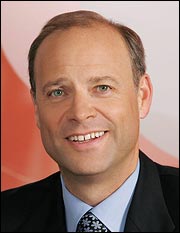 |
| Sanofi CEO Chris Viehbacher |
For another clue to the unrest on Sanofi's ($SNY) board, take a look at the third-quarter earnings report. There's not much red ink on the page, that's true: Sales are up 4%. Earnings up 8%. CEO Chris Viehbacher's growth platforms surged by 10%. The trouble lies in Viehbacher's canned quote.
"We have recently seen a more challenging U.S. diabetes price environment which will impact our diabetes sales throughout 2015," Viehbacher said in Sanofi's earnings release. That bland statement spelled doom to investors, triggering a selloff. Shares dropped the most in 5 years, Reuters notes, and slashed Sanofi's market value by €9.2 billion ($11.7 billion).
During Tuesday's earnings call, analysts zeroed in on the 2015 predictions, pelting dozens of questions at Viehbacher--about Lantus competition, payer contracts, product discounts. While the CEO wasn't willing to speak in detail about competitors and pricing strategy, he repeatedly emphasized that, a., payer pressure is high, which has forced Sanofi to wheel and deal; and b., the diabetes franchise will have a tough year next year because of payer contracts, but it's not doomed. With new products Toujeo--a Lantus follow-up awaiting FDA approval--and the inhaled insulin Afrezza, diabetes is still a growth area. Just not next year.
In the earnings release--and on the call--Viehbacher promised growth from his other platforms, including emerging markets and Genzyme, and touted the latest data on Sanofi's blockbuster hopeful alirocumab, a next-gen cholesterol med, and its dengue vaccine. Plus, there's a new FDA approval--the oral Gaucher disease treatment Cerdelga--and a marketing deal with MannKind ($MNKD) on the inhaled med Afrezza.
But Sanofi's diabetes franchise has been a huge growth driver, thanks to Lantus, which dominates its category. It's by far the biggest seller in Sanofi's entire portfolio, and when it comes to diabetes, Sanofi's other meds are also-rans by comparison. For the quarter, Lantus brought in €1.57 billion, an 8% increase. So far this year, it's racked up €4.57 billion ($5.83 billion), up almost 9%.
Check out the drug's U.S. sales, though. For the year, they're up more than 13%. For the third quarter? 5.8%. That's a big slowdown. With some two-thirds of Lantus sales in the States, growth-engine trouble in the country is a major drag. And now, Sanofi expects its diabetes franchise to sit idling.
Problem is, Sanofi has fueled Lantus growth not only by pumping up volume, but by raising prices. U.S. prices, to be exact. From 2007 to 2013, the price increase amounted to 160%, according to Bloomberg data.
No more. Pricing pressure in the diabetes market is intense, thanks to big payers and their newly exclusionary formularies. While list prices may not change much, rebates are rising, which means a big bite out of net sales. Pharmacy benefits managers Express Scripts, CVS Caremark and their smaller rivals have pitted drugmakers against one another to win discounts, leaving some products out in the cold.
While Lantus isn't one of those products, except in a couple of cases, the Q3 earnings release suggests that Sanofi had to push down prices to keep its preferred placement on some top formularies that went into effect Aug. 1.
Plus, Lantus is now facing biosimilar competition from Eli Lilly ($LLY) and Boehringer Ingelheim, which won European approval of their knockoff version. European sales of Lantus aren't that large, and in the U.S., Sanofi has managed to hold Lilly and Boehringer off with a patent lawsuit. The infringement fight could keep their copycat product off the U.S. market till 2017. But sales erosion in Europe only adds to the pressure on Sanofi's franchise.
The diabetes trouble has had its ripple effects: U.S. chief Anne Whitaker decamped in August; whether voluntarily or not, it's a bad sign. Then there's Viehbacher's own precarious position. Monday, Les Echos reported that restive elements on the company's board were casting about for a successor to the CEO. That group may be small--a letter from Viehbacher to the board posted later mentioned the chairman and two other members. But because Viehbacher went on to argue at length for his job, his opposition must be strong enough.
While the franchise's performance is only one of the grievances raised by recalcitrant board as Reuters points out, Viehbacher didn't proclaim his safety during a call with analysts Tuesday. "I'm the CEO of this company, I'm focused on delivering results," he said. "We're pushing ahead on all fronts."
But talk of an ouster casts a pall over the entire release. As Viehbacher's letter notes, replacing him would seem to signal big trouble for Sanofi. It would show a lack of faith in the company's ongoing climb out of the patent-loss pit. Obviously, the diabetes slowdown doesn't help, either.
"Look, there has always been more to Sanofi than diabetes," Viehbacher said during the earnings call. His challenge now is to persuade his board and investors that the rest of Sanofi's business can take up the slack.
- see the release from Sanofi
- get more from Reuters
Special Reports: Top 10 five-year drug price increases - Lantus | Top 10 pharma companies by employees - Sanofi
Editor's note: This story was updated with information and comments from Sanofi's earnings call with analysts.